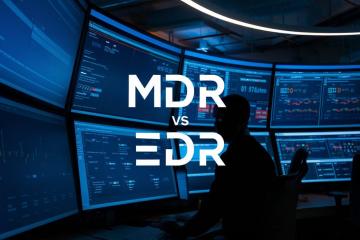Managed detection and response (MDR) refers to a managed cybersecurity service that combines security monitoring, threat detection, investigation, and incident response functions into a single offering. MDR aims to provide organizations with 24/7 threat hunting, detection, and response capabilities without the need for an extensive in-house security team or infrastructure.
As cyber threats grow more advanced and attacks become more targeted, organizations require robust security monitoring and response. However, building an effective in-house security operations center (SOC) requires significant investment in tools and expert staff. MDR offers a more affordable and scalable approach for organizations to augment their security capabilities. With round-the-clock support from cybersecurity specialists, MDR services enable rapid detection and mitigation of threats.
Key Concepts
Definition
Managed detection and response involves utilizing a team of cybersecurity experts along with advanced analytics software to continuously monitor an organization’s IT infrastructure and endpoints, rapidly detect threats and anomalous activity, investigate the scope of incidents, and initiate appropriate response actions. Core capabilities offered include:
- Continuous asset discovery and network topology mapping
- 24/7 monitoring for known and unknown threats
- Investigation via threat hunting exercises
- Rapid containment and remediation guidance when incidents occur
- Customized alerting and comprehensive reporting
While traditional managed security services focus primarily on log analysis and alert monitoring, MDR includes more advanced threat hunting, forensic investigation, and targeted attack simulations to identify stealthy or sophisticated threats.
Purpose
The main purpose of MDR is to provide robust security monitoring, detection, and response capabilities to organizations that lack the resources to effectively handle these tasks in-house. Building an internal SOC with sufficient coverage requires substantial capital and staffing investments. MDR offers the same essential functions through a flexible, cloud-based model that significantly reduces costs and overhead for resource-constrained security teams.
Relevance
As cyberattacks proliferate and threats become more evasive, prompt threat detection and containment are critical to reduce organizational risk. MDR services allow security teams to take advantage of sophisticated attack detection tools and elite security expertise available from dedicated providers. Augmenting internal resources with managed detection and response is an increasingly relevant component of modern enterprise security strategies.
Components/Types
There are two primary delivery models for MDR services:
Fully Managed:
In the fully managed model, the service provider assumes complete responsibility and control for detection and response processes via remote access to client environments. This allows for the fastest possible threat investigation and containment since no client approval or access is required. However, fully managed MDR poses risks around excessive vendor permissions and operational disruption.
Co-Managed:
In the co-managed model, clients retain control over incident response while the MDR provider consults and gives recommendations based on their findings. This allows clients to validate the accuracy of detections and make informed decisions on containment strategies. While response may be slower, organizations minimize risks related to vendor permissions and business disruption.
Importance in Cybersecurity
Security Risks
MDR services can create risks if proper oversight is not established:
- Overprivileged access could enable compromise of sensitive systems and data. Strict controls and auditing around remote access must be maintained.
- False positives in threat detection can significantly impair operations if alerts are not properly validated before initiating disruptive containment tactics.
- Over-reliance on the service could lead to internal security skills and processes atrophying over time. Organizations still need to maintain a base level of cyber-hygiene through vulnerability management, user education, and IT governance.
Mitigation Strategies
Prudent steps for managing risks introduced by MDR include:
- Perform thorough background research on potential vendors, examining factors like security track record, personnel expertise, infrastructure controls, transparency reports, and client references.
- Carefully review proposed permissions models based on access actually required for effective threat analysis. Utilize client-controlled access points when feasible.
- Validate accuracy of detections by replicating vendor investigation methods before approving automated containment or remediation.
- Institute stringent remote access controls like IP whitelisting, 2FA, and privileged access management solutions to secure vendor access points.
- Continuously monitor and audit activity associated with external vendor accounts to detect anomalous or excessive usage.
Best Practices
Effective implementation guidelines for MDR solutions include:
- Clearly delineate response processes and workflows for various threat scenarios based on business risk levels and operational impacts.
- Set well-defined key performance indicators (KPIs) for acceptable threat detection, investigation, and containment timeframes to meet business requirements.
- Establish reliable communications channels and points of contact for collaborating with the vendor during high-severity incidents.
- Continuously fine-tune detection and alerting rules to reduce false positives based on the organization’s unique environment and attack surface.
- Institute controls like change approval boards around containment processes that may cause service disruptions or loss of visibility.
- Maintain skills necessary to effectively collaborate with vendors during complex incident response scenarios involving the MDR solution.
Related Terms
- Security Information & Event Management (SIEM): Collects, aggregates, and analyzes security data from across the IT environment to detect threats. MDR solutions leverage SIEM technologies but are managed by a dedicated security team.
- Security Orchestration, Automation and Response (SOAR): Automates common repeatable tasks to accelerate security operations processes. MDR providers utilize SOAR to enrich threat hunting capabilities.
- Extended Detection & Response (XDR): Consolidates security telemetry, analytics, and controls across multiple layers of the technology stack. MDR solutions apply XDR principles for holistic monitoring.
Key Takeaways
- Managed detection and response (MDR) offers 24/7 monitoring, threat hunting, and security operations capabilities through a managed service provider.
- With the expertise of a dedicated security team, advanced analytics, and rapid response built-in, MDR enhances detection and containment of sophisticated threats.
- MDR allows resource-constrained security teams to take advantage of enterprise-grade capabilities without large capital investments.
- Core components of MDR include asset discovery, continuous monitoring, threat investigation, containment guidance, and reporting.
- Risks related to MDR include overprivileged access, false positives impairing operations, and potential erosion of internal skills.
- Mitigating these risks requires careful vendor selection, controlled permissions, validation of detections, activity monitoring, and maintaining some internal capabilities.
- Effective MDR implementation relies on calibrated alerting rules, response workflows based on risk scenarios, communications plans, and closely tracking vendor performance.
- With risks addressed, MDR fills a key gap for modern security teams overwhelmed by growing threats requiring rapid coordinated response.


